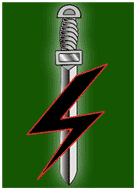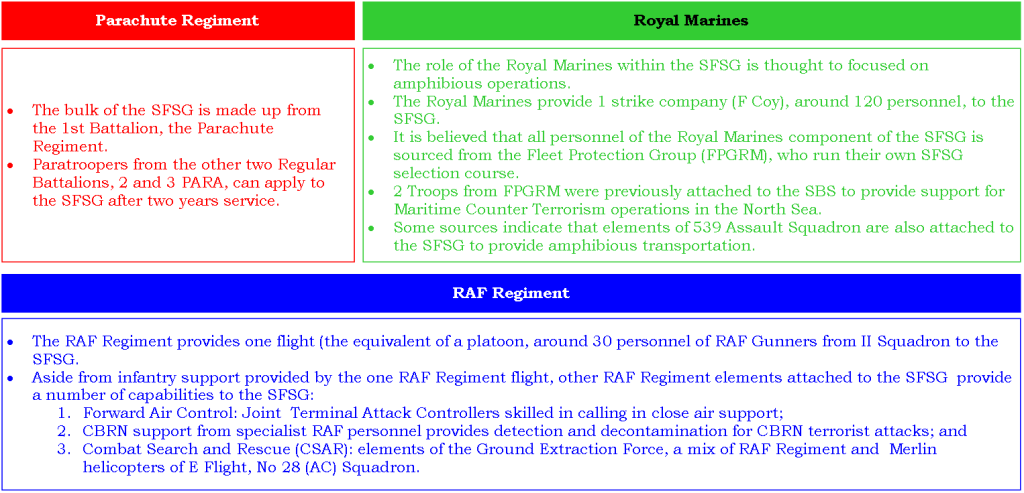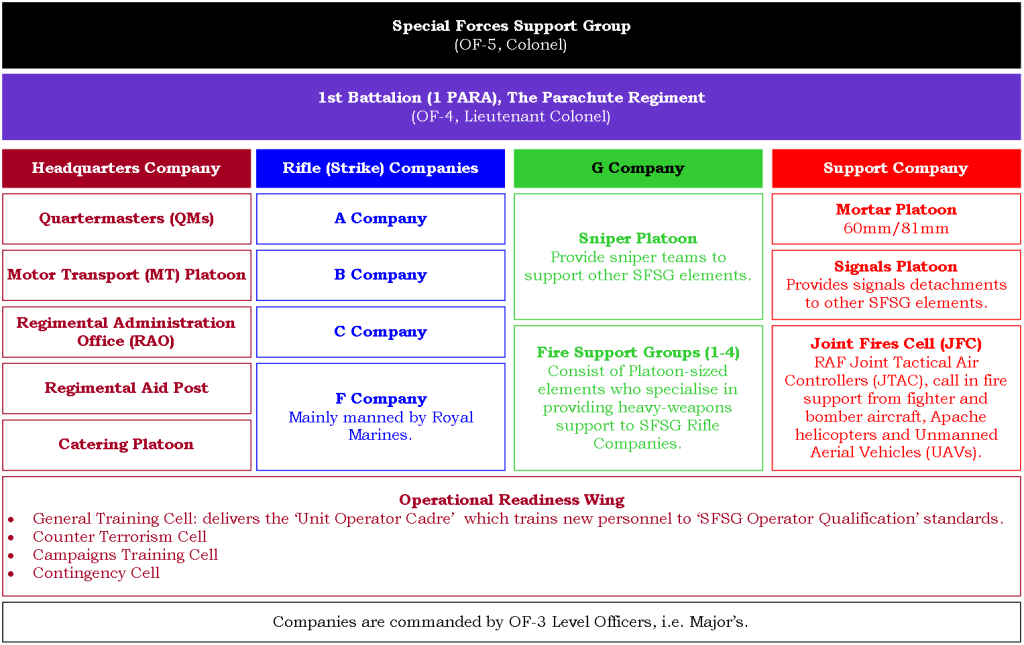PART ONE: BACKGROUND
 1.0 Introduction
1.0 Introduction
The Special Forces Support Group (SFSG) is Britain’s newest special operations unit. Formed around a core component of members of the 1st Battalion, Parachute Regiment (1 PARA), with additional troops from the Royal Marines and the RAF Regiment, the SFSG provides infantry and specialised support to Special Air Service (SAS) and Special Boat Service (SBS) operations. The SFSG is part of the United Kingdom’s Special Forces (UKSF) Group which is commanded by the Director Special Forces, a Major General (OF-7).
The SFSG was officially formed on 03 April 2006 to provide direct support to the UKSF on operations. As 1 Para had fulfilled this role on previous operations (Op BARRAS, Sierra Leone), they were selected to provide the bulk of the Army manning. Additional numbers being provided by a company of Royal Marines and a platoon from the RAF Regiment. The SFSG is located at Churchill Lines, MOD St Athan in the Vale of Glamorgan and since 2006 has fulfilled its role on both Op HERRICK and TELIC. The SFSG has the usual plethora of support cap badges.
The SFSG, in its current format is made up of four Strike Companies (A, B, C and F), Support Company and D (HQ) Company. There is a Strike Company permanently on operations and the other Companies are either:
- Coming off operations;
- Undergoing Pre-Deployment Training (PDT) in readiness to deploy onto operations; or
- Undertaking training for, and fulfilling, the SFSG’s Standby role and UK-based high readiness commitments.
The SFSG are not Special Forces, but they are special in comparison to any other infantry battalion, and the training, equipment and ethos reflects this. The pace of life is fast and furious, but with enough quality down time for individuals to take care of themselves and their families.
1.1 Women and the SFSG
In accordance with current Government policy on the employment of women in the UK military, service in the SFSG is only open to male volunteers. However, appointments do exist for women within the Army units that support the SFSG, for example Human Resources.
On 08 July 2016, the MOD announced that all Ground Close Combat Roles (RAC, Infantry, Royal Marines and the RAF Regiment) would be opened to women by 2018 (British Army, 2016).
1.2 Tier 1 and Tier 2 Special Forces
The SFSG is considered a Tier 2 unit. A ‘Tier 1’ SF unit, for example 22 SAS Regiment, is usually tasked with direct action. Other special operations forces (SOF) are referred to as ‘Tier 2’ units as they, usually, fulfil a supporting role for the Tier 1 units.
1.3 Selection and Training for SFSG
 The British Army’s website states that on completion of their first two years in 2 or 3 PARA, soldiers may be selected for a tour with 1 PARA (British Army, 2014).
The British Army’s website states that on completion of their first two years in 2 or 3 PARA, soldiers may be selected for a tour with 1 PARA (British Army, 2014).
The website then goes on to state that the basic skills required to serve in 1 PARA are those soldiers will have gained during their initial training and during their time in 2 or 3 PARA. Soldiers receive further training on additional weapons, communications equipment and specialist assault skills.
Soldiers within The Parachute Regiment rotate through the SFSG during their careers to ensure that advanced military skills, found nowhere else in the infantry, are maintained throughout the three Battalions.
The SFSG was initially composed of personnel from the British Army’s Parachute Regiment, the Royal Marines and the RAF Regiment, but is now open to all personnel in the UKs Armed Forces that have passed:
- The All Arms Pre-Parachute Selection (AAPPS, aka P-Company) course delivered by the Parachute Regiment;
- The All Arms Commando Course (AACC) delivered by the Royal Marines; or
- The Royal Air Force Pre-Parachute Selection course delivered by No.2 Squadron, RAF Regiment.
British Army personnel can apply to join the SFSG straight from the AAPPS course irrespective of regimental affiliation; prospective recruits from the Royal Marines undergo a selection process run by the Fleet Protection Group Royal Marines. Unsure of the selection process for No.2 Squadron, RAF Regiment.
Members continue to wear their own cap badge. In addition, personnel wear a new shoulder emblem that depicts a silver dagger on a green background, with a red-lined black flash of lightning running through it.
PART TWO: OUTLINE OF THE SFSG
2.0 SFSG Roles
The SFSG has a specialist role as the only infantry unit in direct support of, and working alongside, the UKSF.
As such, the principal role of the SFSG is to provide direct support to UKSF intervention operations, as well as reinforcing UKSF in other key capability areas such as provision of specialist training and support to domestic counter terrorist (CT) operations. It has a specific specialist infantry role and personnel are equipped and trained accordingly.
The SFSG also fulfil a number of other duties which complement its principal role and include:
- Acting as a quick reaction force for SAS/SBS operations;
- Sealing off and guarding an area of operation;
- Taking part in large scale offensive operations alongside SAS/SBS forces;
- Carrying out secondary assaults and diversionary raids;
- Acting as a ‘blocking force’ against counter attacks;
- Training / mentoring foreign militaries;
- CBRN detection/protection; and
- Domestic anti-terrorist support.
A model for the kind of operation that the SFSG has been created for can be seen in the 2000 Sierra Leone ‘Operation Barras’, in which elements of 1 PARA attacked a rebel base whilst the SAS/SBS rescued fellow soldiers from a nearby camp. A comparable relationship exists between the 75th Ranger Regiment and SFOD-1 (Delta Force) in the US Military. The Rangers provided perimeter security for Delta Force operations in Somalia in 1993, as portrayed in the film, Black Hawk Down.
Apart from giving direct support to SAS/SBS missions, the SFSG also provides specialist training support. One of the traditional roles of the SAS has been to provide foreign militaries with specialist training. Since much of this training does not necessarily require the skills of the SAS, such training tasks can now be performed by members of the SFSG, thus freeing the SAS up for direct combat missions.
It is also believed that the SFSG will also support the police during domestic terrorist incidents. The precise nature of this support is not publicly known but it is speculated that it may include providing additional area security around a large scale terrorist incident. Some sources indicate that elements within the SFSG have received counter-terrorist (CT) training from the SAS. Such SFSG CT elements would be able to assist the SAS/SBS in large scale CT operations. It’s also believed that CBRN (Chemical, Biological, Radioligical & Nuclear) specialists from the SFSG would assist in event of a domestic terrorist attack.
2.1 SFSG Components
Personnel for the SFSG are drawn from the Parachute Regiment, the Royal Marines, and the RAF Regiment as highlighted in Figure 1 below.
Figure 1: SFSG Components
2.2 SFSG Organisation
The exact SFSG order of battle (ORBAT) has not been disclosed to the public domain, although some details can be gleaned from open source publications. The SFSG is structured (Figure 2) in a similar manner to a regular Parachute Regiment battalion, the most notable differences being the addition of F Company Royal Marines and the Joint Fires Cell.
Figure 2: SFSG Organisation
PART THREE: MISCELLANEOUS
3.0 Government Austerity and the SFSG
In March 2013 the Sunday Telegraph, a British newspaper, published details of proposed cuts in UKSF (Rayment, 2013).
The newspaper reported that UKSF personnel, mainly from Tier 2 units (particularly the SFSG), could be cut by up to 40% with the move of the two reserve SAS units to the regular British Army.
The MOD stated the restructuring programme was part of on-going cost-savings across the Armed Forces of the United Kingdom.
3.1 References
British Army. (2014) 1 PARA. Available from World Wide Web: http://www.army.mod.uk/infantry/regiments/parachute/24104.aspx. [Accessed: 06 August, 2014].
British Army (2016) Ground Close Combat Roles Open To Women. Available from World Wide Web: http://www.army.mod.uk/news/28632.aspx. [Accessed: 08 August, 2016].





Hi , SFSG wear the maroon beret ?
LikeLike
Hi,
SFSG members continue to wear their own cap badge. In addition, personnel wear a new shoulder emblem that depicts a silver dagger on a green background, with a red-lined black flash of lightning running through it.
LikeLiked by 1 person
Thanks
LikeLike
Is it possible for someone from The Rifles to hold 4 cap badges during service, to be in SFSG without having done P Coy, and to be a Royal Marine as well?
I have listened to an interview on a podcast and find the claims difficult to believe.
LikeLike
Hi Frank,
A complicated question I will endeavour to answer.
Simple Answer: (technically) Yes.
Longer Answer:
1a. You can apply to join the SFSG without having completed P Coy (of which there are two variations, the RAF PPS and AA PPS) but only if you are a Royal Marine (but not AACC qualified personnel as far as I am aware).
1b. Personnel in the SFSG retain their parent cap badges.
2a. Most personnel will have one cap badge only within their military career.
2b. However, it is not uncommon for a minority of personnel to have two cap badges during their career. For example personnel who transfer to another Corps such as the Royal Army Physical Training Corps (RAPTC) or Small Arms School Corps (SASC) and Infantry personnel who transfer to Combat Support (CS) or Combat Service Support (CSS) Corps/Services. Personnel generally don’t transfer from a CS/CSS unit to the Infantry (exceedingly rare but not unheard of).
2c. An even smaller minority may have a third cap badge. For example, those who transferred to the RAPTC or SASC may apply for a Late Entry (LE) Commission, which does not have to be in the same Corps. For instance, some SASC LE candidates seek a commission in the Education Corps.
2d. A candidate who had ‘worn’ four cap badges within their career would most likely have started in the Royal Marines, transferred to The Rifles and then maybe followed Points 2b and 2c.
2e. More personnel transfer from the Royal Marines than to the Royal Marines.
2f. Transfer criteria differ between the Arms and Services.
LikeLike
Can RAF Regiment Officers join the SFSG?
LikeLike
Hi Scott,
As I understand it, (appropriately qualified) RAF Regiment Officers can be employed within the SFSG in both staff and leadership roles, although numbers are low.
LikeLike